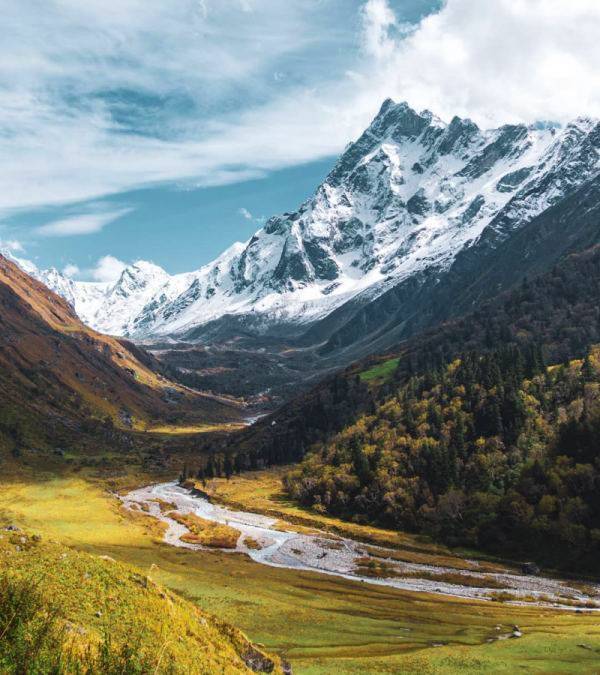Discover the Secret Season for the Charming Views on Har Ki Dun Trek
Sep 24, 2024 Anil DabadThe Himalayas are an ideal destination for hiking, trekking and out of all the trekking routes the 5 days Har Ki Dun trek is one of the most scenic treks. The Har Ki Doon Valley is located at an altitude of 3556 meters in the Western Garhwal Himalayas. This trek is popular for its diverse, serene and spectacular natural beauty in addition to interactions with the cultural communities…thus highly recommended for nature lovers/adventurers. Regarded as the ‘Valley of Gods,’ it is believed that God’s path follows the Pandavas’ trail as they went seeking heaven in Mahabharata. The trek is approximately 47 km where one is taken through the Pine, Deodar, and Rhododendron forests, typical mountain streams, beautiful and authentic villages, and the lively Supin River. The trek is of moderate level nature and hence can be attempted by first-time trekkers as well as professional trekkers.
Why Timing is Crucial when it comes to Planning for the Har Ki Dun Trek
Timing the trek in Uttarakhand particularly for the Har Ki Dun Trek is very important. Seasons in general climate have an impact on the circumstances of the weather, trail and natural beauty of the place thus enhancing the experience of trekking. Choosing the best time also reduces unfavourable weather conditions of the trail, and the scenery making the trek more fun and a good experience. Here is the detailed guide to Har Ki Dun Trek to choose the best time for the trekking.
Seasonal Weather Guide to the Har Ki Dun Trek:-
1. Spring (March to April)

Pros:-
Pleasant Weather: The temperature during spring is moderate, and it is slightly cold, starting from 14 °C to 20 °C during the day. Comfort during trekking is caused by the cool breeze and fresh air that reduce the level of hotness during the exercise.
Blooming Flowers: The population takes on the palette of flowers; the familiar sight of the valley becomes enlightening as it turns into a blooming of rhododendrons and other wildflowers.
Cons:-
Slippery Trails: The trails may be slippery following a meltdown by the sun; hence, one must be careful to avoid falling while on the trails.
Possible Light Rainfall: Occasionally, light showers might be experienced early in spring, and this makes the trail muddy, which would make it harder.
2. Summer (May to June)

Pros:-
Stable Weather: The summer is comparatively more favourable with a fixed and precise climate having an average temperature ranging between 18°C and 25°C that is congenial for trekking.
Longer Days: It would be better for the trekkers because they have more time during the day to cover distance and also have better views.
Great for Photography: The contrast, principally by the brightness of the light, the clarity of the skies and the colour of the landscapes makes for a very good photo snap.
Cons:-
Crowded Trails: Summer is preferred when it comes to trekking because the environment is dry but there are lots of people on the trails which spoils the feeling of being alone.
Higher Costs: The cost of accommodation tends to rise due to the influx by trekkers, therefore, early booking is recommended.
3. Autumn (September to November)

Pros:-
Clear Skies: Autumn can be characterized by clear weather and proper visibility, thus it is fine for mountain and valley sightseeing.
Stable Weather: Moderately warm and comparatively less Rainy this remains one of the best seasons for trekking.
Fall Colors: There is absolutely every guarantee to make the trek through the valley pleasant through the beautiful colours of fall.
Cons:-
Cooler Temperatures: It rains at times, and what is worse the weather in the higher areas is comparatively colder, especially at night and before dawn, trekkers should prepare themselves for such.
Shorter Days: Shorter days restrict the amount of time and energy that can be spent hiking to camps, and en-route planning of the same.
Best Months for Har Ki Dun Trek:
The appropriate time for the Har Ki Dun Trek is between April and June as well as September and November. These months offer the best mountain weather conditions for a safe and enjoyable trekking experience. Ultimately, the best time depends on your preferences and preparedness. Thus, taking into consideration these favourable months and their concomitant combination with your preferences and stamina, you can achieve a meaningful and enjoyable trekking experience.
Planning Your Har Ki Dun Trek with Hikers 360
Organizing your trek during these favourable months makes a difference because it is safe and fun to trek. Autumn and spring seasons offer the best weather conditions, stunning natural beauty, and clear skies for breathtaking views. At this time of the year, the trails are not hindered by the extreme regularity in your weather and so your travel is made easier.
Whether you're a beginner or an experienced trekker, Har Ki Dun is recorded to offer a fabulous experience. Har Ki Doon Valley is a paradise for nature lovers and adventure seekers. So, pack your backpack, choose the right season group date, and go through the Valley of the Gods journey. Your adventure awaits!


Anil Dabad
I'm a passionate mountaineer, Nature Lover, Adventure Traveller & ambitious person who loves to work for my passion. A freaking Adventure Lover.
Post a Comment
Leave a reply:
Your can comment after login
